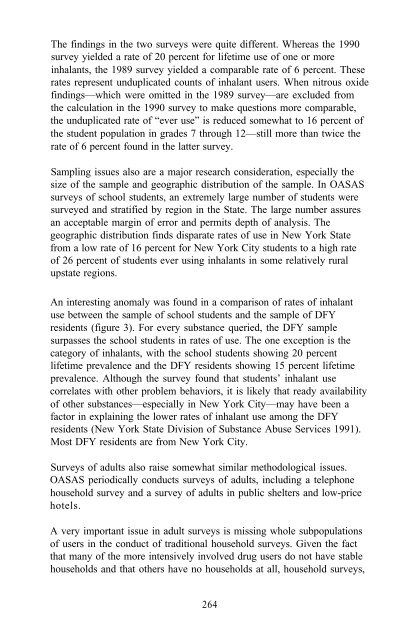Epidemiology of Inhalant Abuse - Archives - National Institute on ...
Epidemiology of Inhalant Abuse - Archives - National Institute on ...
Epidemiology of Inhalant Abuse - Archives - National Institute on ...
Create successful ePaper yourself
Turn your PDF publications into a flip-book with our unique Google optimized e-Paper software.
The findings in the two surveys were quite different. Whereas the 1990<br />
survey yielded a rate <str<strong>on</strong>g>of</str<strong>on</strong>g> 20 percent for lifetime use <str<strong>on</strong>g>of</str<strong>on</strong>g> <strong>on</strong>e or more<br />
inhalants, the 1989 survey yielded a comparable rate <str<strong>on</strong>g>of</str<strong>on</strong>g> 6 percent. These<br />
rates represent unduplicated counts <str<strong>on</strong>g>of</str<strong>on</strong>g> inhalant users. When nitrous oxide<br />
findings—which were omitted in the 1989 survey—are excluded from<br />
the calculati<strong>on</strong> in the 1990 survey to make questi<strong>on</strong>s more comparable,<br />
the unduplicated rate <str<strong>on</strong>g>of</str<strong>on</strong>g> “ever use” is reduced somewhat to 16 percent <str<strong>on</strong>g>of</str<strong>on</strong>g><br />
the student populati<strong>on</strong> in grades 7 through 12—still more than twice the<br />
rate <str<strong>on</strong>g>of</str<strong>on</strong>g> 6 percent found in the latter survey.<br />
Sampling issues also are a major research c<strong>on</strong>siderati<strong>on</strong>, especially the<br />
size <str<strong>on</strong>g>of</str<strong>on</strong>g> the sample and geographic distributi<strong>on</strong> <str<strong>on</strong>g>of</str<strong>on</strong>g> the sample. In OASAS<br />
surveys <str<strong>on</strong>g>of</str<strong>on</strong>g> school students, an extremely large number <str<strong>on</strong>g>of</str<strong>on</strong>g> students were<br />
surveyed and stratified by regi<strong>on</strong> in the State. The large number assures<br />
an acceptable margin <str<strong>on</strong>g>of</str<strong>on</strong>g> error and permits depth <str<strong>on</strong>g>of</str<strong>on</strong>g> analysis. The<br />
geographic distributi<strong>on</strong> finds disparate rates <str<strong>on</strong>g>of</str<strong>on</strong>g> use in New York State<br />
from a low rate <str<strong>on</strong>g>of</str<strong>on</strong>g> 16 percent for New York City students to a high rate<br />
<str<strong>on</strong>g>of</str<strong>on</strong>g> 26 percent <str<strong>on</strong>g>of</str<strong>on</strong>g> students ever using inhalants in some relatively rural<br />
upstate regi<strong>on</strong>s.<br />
An interesting anomaly was found in a comparis<strong>on</strong> <str<strong>on</strong>g>of</str<strong>on</strong>g> rates <str<strong>on</strong>g>of</str<strong>on</strong>g> inhalant<br />
use between the sample <str<strong>on</strong>g>of</str<strong>on</strong>g> school students and the sample <str<strong>on</strong>g>of</str<strong>on</strong>g> DFY<br />
residents (figure 3). For every substance queried, the DFY sample<br />
surpasses the school students in rates <str<strong>on</strong>g>of</str<strong>on</strong>g> use. The <strong>on</strong>e excepti<strong>on</strong> is the<br />
category <str<strong>on</strong>g>of</str<strong>on</strong>g> inhalants, with the school students showing 20 percent<br />
lifetime prevalence and the DFY residents showing 15 percent lifetime<br />
prevalence. Although the survey found that students’ inhalant use<br />
correlates with other problem behaviors, it is likely that ready availability<br />
<str<strong>on</strong>g>of</str<strong>on</strong>g> other substances—especially in New York City—may have been a<br />
factor in explaining the lower rates <str<strong>on</strong>g>of</str<strong>on</strong>g> inhalant use am<strong>on</strong>g the DFY<br />
residents (New York State Divisi<strong>on</strong> <str<strong>on</strong>g>of</str<strong>on</strong>g> Substance <str<strong>on</strong>g>Abuse</str<strong>on</strong>g> Services 1991).<br />
Most DFY residents are from New York City.<br />
Surveys <str<strong>on</strong>g>of</str<strong>on</strong>g> adults also raise somewhat similar methodological issues.<br />
OASAS periodically c<strong>on</strong>ducts surveys <str<strong>on</strong>g>of</str<strong>on</strong>g> adults, including a teleph<strong>on</strong>e<br />
household survey and a survey <str<strong>on</strong>g>of</str<strong>on</strong>g> adults in public shelters and low-price<br />
hotels.<br />
A very important issue in adult surveys is missing whole subpopulati<strong>on</strong>s<br />
<str<strong>on</strong>g>of</str<strong>on</strong>g> users in the c<strong>on</strong>duct <str<strong>on</strong>g>of</str<strong>on</strong>g> traditi<strong>on</strong>al household surveys. Given the fact<br />
that many <str<strong>on</strong>g>of</str<strong>on</strong>g> the more intensively involved drug users do not have stable<br />
households and that others have no households at all, household surveys,<br />
264
















